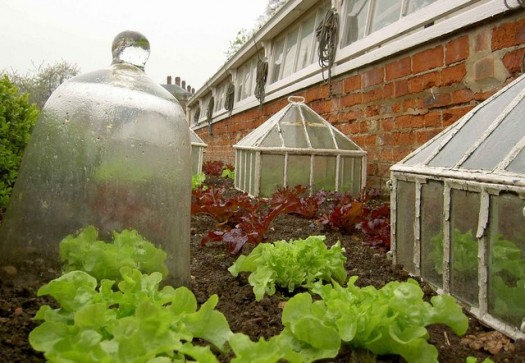Gardeners have used coverings to protect plants and to extend the growing season for centuries. These coverings can be as elaborate as heated glass greenhouses, or as simple as a plastic bag supported over a single plant. Temporary shelters are known as cloches, and can be almost any size or shape. Sheltering your plantings with cloches offers protection in four different ways:
- Trapping heat with the greenhouse effect. The sun’s rays have radiant energy that becomes heat energy when it strikes the soil under cover. This warmth accelerates the growth of the plants.
- Protection from damaging rain. Heavy spring rains can compact the soil surface and wash seeds out of their soil covering. Wet conditions also encourage rot and disease, and can even rot germinating seeds.
- Protection from frost. By covering plantings in early spring and late fall, there is less transfer of the heat in the soil to the surrounding nighttime cool air, so plants do not freeze.
- Protection from winds. Winds can damage plants by knocking them over or breaking stems. It also chills them. A covering will deflect damaging winds.
Any material that transmits light can be used to make a cloche. The original cloches (the French word for bell) resembled glass bells, and each one sheltered a single plant. Today, we have many possibilities – plastic containers with bottoms removed, recycled windows, supported plastic sheets, or commercially made cloches. One of the most efficient and useful cloches can be easily made to cover an entire raised planting bed, thus functioning as a mini greenhouse.
Cloches that you make yourself have three main advantages:
- They are low cost.
- They are easy to build and move.
- They can be made to a desired size.
Here is how to make a lightweight portable cloche that is both economical and reusable:
From sections of 2X2 lumber, make a rectangular frame 4 feet by 6 feet, screwed and braced on the 4 corners. Drill a 1 inch hole in each corner, but not all the way through. Insert two ten foot lengths of three quarter inch PVC pipe into the corner holes, and across diagonally, so they form an arched framework crossing in the center, much like a tent frame.
Now, lay a 6 mil poly sheet over the framework, and staple it snugly along the 6 foot sides first. Then snug it along the other two sides, and staple. You’ll need to fold over the excess at the corners, sort of like how you gift wrap a box. Staple it down, and cover the staples on all four sides with duct tape. Trim off any excess plastic from the bottom.
This lightweight cloche can be set over a raised bed, over a grouping of plants, or even over a freshly seeded area. You can easily lift it off for watering and weeding, or lift and support one side up for ventilation.
Build this simple cloche, and use your ingenuity to design and create others to fit your needs. With just a little expense and a bit of carpentry skill, you can add months to your gardening pleasure.
The Author:
Gardening expert Nicolette Goff blogs about her passion of gardening.
